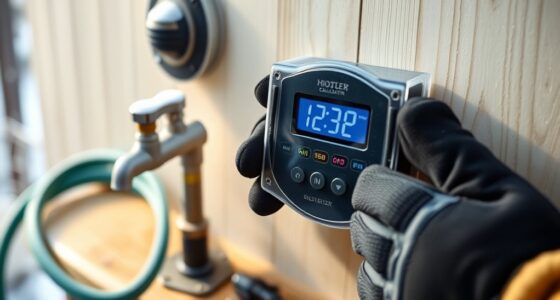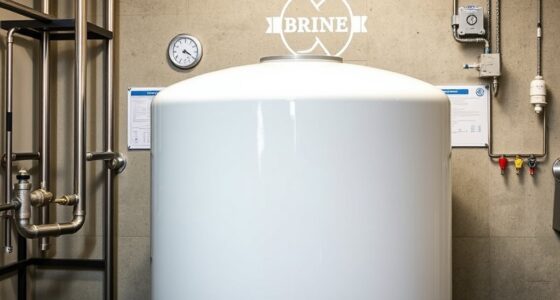To master PEX versus copper troubleshooting in a weekend, focus on understanding their main differences—flexibility, corrosion resistance, and installation needs. Learn to spot leaks, pinholes, and pressure issues quickly by inspecting for moisture, rust, or flow restrictions. Use the right tools for repairs and replace worn sections proactively. With ongoing tips and techniques, you’ll improve your skills fast—continue exploring to uncover even more practical insights.
Key Takeaways
- Understand the unique installation challenges of PEX (flexibility, fewer fittings) versus copper (rigidity, precise fittings).
- Learn to detect leaks early using visual inspections, water testing, and specialized leak detection tools for both materials.
- Assess water pressure and flow restrictions by measuring at multiple points and inspecting for sediment or corrosion.
- Identify corrosion signs and material deterioration to prevent leaks, applying protective measures or replacing affected sections.
- Follow preventative maintenance practices like insulation, water softening, and routine inspections to extend pipe lifespan.
Understanding the Key Differences Between PEX and Copper
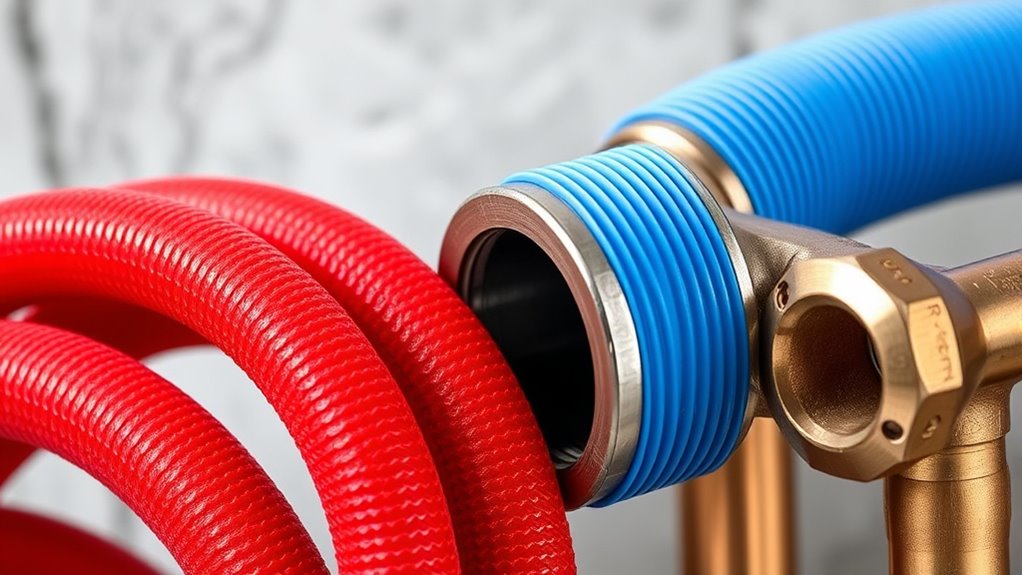
When choosing between PEX and copper pipes, understanding their key differences helps you make an informed decision. PEX offers exceptional flexibility, allowing you to bend and install it in tight spaces without fittings, which simplifies the process. Copper, on the other hand, has high conductivity, making it excellent for heat transfer and durable over time. While copper pipes are rigid and require precise measurements and fittings, PEX’s flexibility reduces the need for many joints, lowering potential leak points. Copper’s conductivity makes it ideal for hot water lines, but it’s more prone to corrosion if not properly maintained. PEX is resistant to corrosion and scale buildup, making it more durable in certain environments. Recognizing these differences helps you choose the right material for your plumbing needs. Additionally, the aesthetic appeal of copper pipes can add a vintage charm to exposed plumbing, which some homeowners find desirable.
Recognizing Common Installation Challenges and Solutions

You should regularly check for leaks during and after installation to catch issues early. Make sure your fittings are properly secured and tightly connected to prevent future problems. Addressing these common challenges promptly helps make certain your plumbing system functions smoothly and efficiently. Incorporating mindfulness and awareness during installation can also help you identify potential issues before they escalate. Spiritual awareness can enhance your focus and precision in handling delicate fittings and connections.
Identifying Leaks Early
Early detection of leaks is essential to prevent costly damage and guarantee the integrity of your plumbing system. Start by regularly inspecting visible pipes for signs of moisture or corrosion. Pay close attention to areas with inadequate pipe insulation, as exposed sections are more vulnerable to leaks. Keep an eye on the water flow rate; a sudden decrease or irregular pressure may signal a leak somewhere in the system. Use your senses—listen for dripping sounds or feel for damp spots. Checking connections and fittings regularly helps catch issues early. When you notice a change, act promptly to identify the source before it worsens. Regular maintenance can also prevent future leaks by ensuring all components are functioning correctly. Early detection saves you time, money, and stress by stopping leaks before they cause significant damage.
Ensuring Proper Fittings
Proper fittings are essential to maintaining a leak-free plumbing system. To guarantee this, you must check fitting compatibility carefully. Using mismatched fittings can compromise joint security, leading to leaks or failures. Always verify that the fittings are designed for PEX or copper, depending on your material choice. When installing, ensure fittings are fully seated and properly secured with the right tools. Avoid over-tightening, which can damage fittings and jeopardize joint security. Properly cut and deburr pipes before attaching fittings to prevent gaps or misalignments. Regularly inspect connections during installation and after completion. Correct fitting selection and installation are key to a reliable, long-lasting plumbing system, saving you troubleshooting time later. Additionally, paying attention to material compatibility ensures that the fittings and pipes work harmoniously, reducing the risk of corrosion or deterioration over time. Focusing on fitting compatibility and joint security prevents common challenges and ensures a successful setup.
Troubleshooting Leaks and Pinholes in PEX and Copper Lines

When you notice leaks or pinholes, the first step is to identify where the water is coming from. Pinpointing the exact source helps you determine whether the issue is caused by corrosion, improper installation, or material failure. Once you know the cause, you can choose the most effective repair method to fix the problem quickly and prevent future leaks. Understanding data privacy challenges can also help you ensure that your repair process complies with relevant regulations and protects sensitive information.
Detecting Leak Sources
Detecting leak sources in PEX and copper lines requires a systematic approach to pinpoint the exact location of pinholes or cracks. Start by inspecting visible pipe sections for signs of moisture or corrosion. Next, use water testing by shutting off the water supply and observing pressure drops or wet spots. Finally, consider pipe insulation; carefully remove sections if necessary to check for hidden leaks behind walls or in tight spaces. Using specialized leak detection tools can further assist in identifying elusive leaks that are not visible to the naked eye. Following these steps helps you narrow down leak origins efficiently, ensuring you target the problem directly without unnecessary guesswork.
Pinpointing Pinhole Causes
Pinpointing the causes of pinholes in PEX and copper lines is essential for effective leak repair and long-term system integrity. To do this, carefully inspect the affected areas for signs of material deterioration, which often leads to pinholes. In copper pipes, corrosion from water chemistry or galvanic reactions can weaken the metal, causing tiny holes over time. For PEX, chemical damage or exposure to UV rays may cause the material to degrade and develop pinholes. Look for discoloration, crusting, or cracking around the leak site. Identifying whether the damage stems from material deterioration or external factors helps you determine the root cause, so you can prevent future issues and choose the right repair or replacement approach. Conducting regular inspection and maintenance can help catch these issues early before significant damage occurs.
Effective Repair Strategies
Effective repair strategies for leaks and pinholes in PEX and copper lines require a clear understanding of the damage and appropriate techniques. First, assess whether the issue stems from corrosion, physical damage, or improper installation. Next, consider the role of pipe insulation and water temperature, as high temperatures can accelerate deterioration. To fix the problem:
- Turn off the water supply and drain the line.
- Use appropriate fittings or repair sleeves to patch leaks, ensuring a tight seal.
- Insulate the repaired section to prevent future damage, especially if water temperature fluctuates.
- Incorporate AI-powered diagnostics to identify hidden issues more efficiently.
Assessing Water Pressure Issues and Flow Restrictions
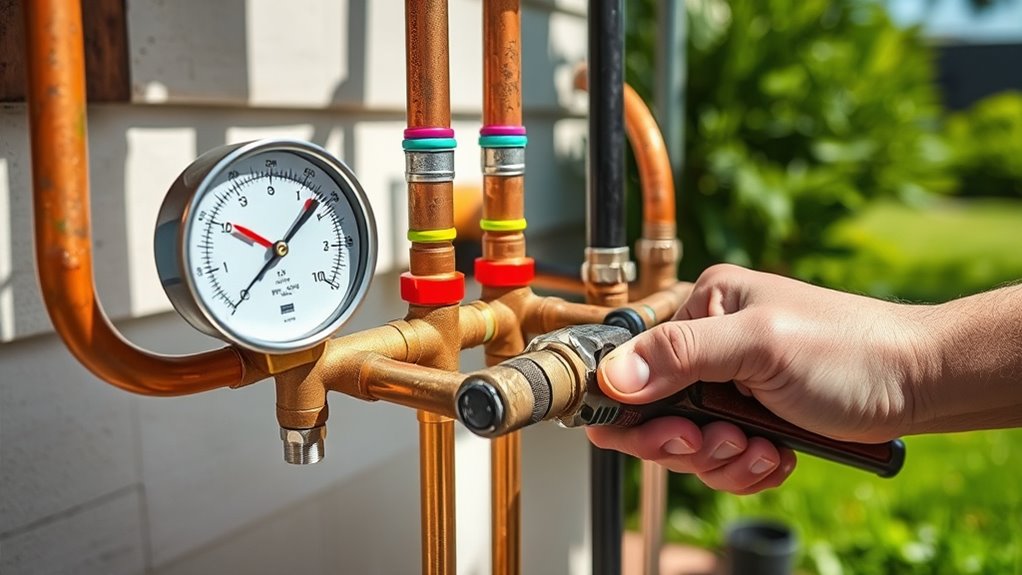
When water pressure drops or flow rates seem sluggish, it’s essential to assess the system thoroughly to identify the cause. Start by checking for flow restrictions, especially around your water heater and pipe insulation. Blockages or buildup can reduce flow, impacting performance. Inspect for leaks or kinks in PEX or copper pipes. Sometimes, debris or sediment inside pipes cause flow issues. Use a pressure gauge to measure water pressure at different points; inconsistent readings point to clogs or restrictions. Consider whether mineral deposits are affecting flow, especially in older pipes. Regular maintenance and flushing can help prevent pipe blockages and ensure consistent water flow.
Identifying and Correcting Corrosion and Material Deterioration
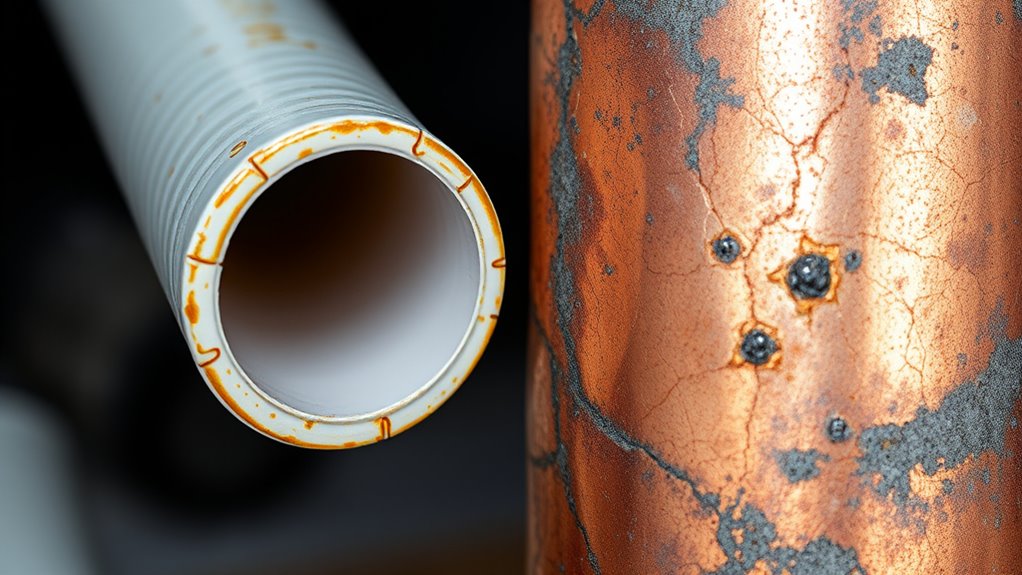
Water pressure issues and flow restrictions often stem from more than just blockages or sediment; they can also result from corrosion and material deterioration within the pipes. To identify these problems, start by inspecting visible pipe sections for discoloration, pitting, or scaling. Next, use a magnet or metal detector to check for weak spots indicating corrosion. Finally, verify material compatibility—certain pipe materials are more prone to deterioration when exposed to specific water chemistries. To correct these issues, prioritize corrosion prevention methods like applying protective coatings or replacing affected sections. When repairing, ensure compatibility between materials to prevent further deterioration. Regular inspections and choosing pipes suited for your water conditions help maintain flow and extend pipe life, avoiding costly repairs down the line. Additionally, understanding cookie management and how it influences information sharing can support better maintenance decisions.
Tools and Techniques for Efficient PEX and Copper Repair

To repair PEX and copper pipes efficiently, you need the right tools and techniques that match each material’s specific requirements. For PEX, use a PEX crimp or clamp tool to guarantee secure connections, and consider pipe insulation to prevent heat loss and maintain water temperature. Copper repairs require a pipe cutter, torch, and soldering kit for secure, leak-proof joints. Proper pipe insulation is also crucial for copper pipes, especially in extreme temperatures, to prevent freezing or excessive heat loss. When working with water temperature, always verify the system’s settings before starting repairs to avoid scalding or inadequate flow. Using the correct tools combined with insulation techniques ensures efficient repairs, reduces future problems, and maintains essential water temperature during and after the repair process.
Preventative Measures to Minimize Future Plumbing Problems

Implementing regular maintenance is essential to prevent future plumbing issues. Start by insulating pipes with high-quality pipe insulation to avoid freezing during cold weather. Next, consider installing a water softening system to reduce mineral buildup that can damage pipes over time. Ultimately, schedule routine inspections to identify early signs of wear or leaks. This proactive approach helps you catch problems before they escalate. Regularly check insulation integrity, especially around vulnerable areas, and ensure your water softener is functioning properly. By maintaining these simple measures, you minimize the risk of pipe corrosion, blockages, and costly repairs. Taking these steps keeps your plumbing system efficient and prolongs its lifespan, saving you time and money in the long run.
Frequently Asked Questions
How Do I Determine When to Replace PEX Versus Repairing Copper Pipes?
You should replace PEX pipes when you notice persistent leaks, visible damage, or pipe corrosion that can’t be repaired easily. Repair copper pipes if leaks are minor, and leak detection shows localized issues. If corrosion or extensive damage is present on copper, replacing the entire section is best. For PEX, consider replacement if leaks recur after repairs or if the pipe shows signs of deterioration, ensuring your plumbing stays reliable and safe.
What Safety Precautions Should I Take During Plumbing Troubleshooting?
You should always wear personal protective gear like gloves and safety goggles to prevent injuries, and never neglect electrical safety when working near wiring or outlets. Investigate the theory that safety precautions slow down work—actually, they prevent accidents that cause delays. Always turn off water supply and electricity before troubleshooting. Confirm that power is off with a tester. Taking these steps ensures your safety and keeps your project on track.
Are There Specific Tools Recommended for Mixed PEX and Copper Systems?
You should use specific tools like pipe fittings that are compatible with both PEX and copper systems, along with a leak detection kit to identify issues quickly. A crimp or clamp tool is essential for secure connections in PEX, while a pipe cutter works well for copper. Having a good wrench and pipe wrench on hand helps tighten fittings properly. These tools make troubleshooting mixed systems more efficient and guarantee reliable, leak-free connections.
How Can I Identify Hidden Leaks Behind Walls or Underground?
To identify hidden leaks behind walls or underground, you should use moisture detection tools like a moisture meter or infrared camera for wall inspection. These devices help you spot damp spots or temperature changes indicating hidden leaks. Carefully inspect wall surfaces and use the moisture detection equipment to scan areas where water damage is suspected. For underground leaks, consider using acoustic leak detection or ground-penetrating radar for precise location.
What Are the Environmental Impacts of Choosing PEX Over Copper?
Ironically, choosing PEX over copper might seem like an eco-betrayal, but it actually offers recycling benefits and better material sustainability. PEX’s flexibility reduces waste during installation, and its longer lifespan lessens environmental impact. Plus, using PEX minimizes energy consumption during manufacturing. So, you’re not just saving time on troubleshooting—you’re making an environmentally smarter choice that supports recycling efforts and promotes sustainable building practices.
Conclusion
Mastering PEX and copper plumbing isn’t just about fixing leaks or pressure issues—it’s about understanding their differences and vulnerabilities. While PEX offers flexibility, copper provides durability. But both require attention and care. By troubleshooting wisely and applying preventative measures, you build a resilient system. Remember, neither material is invincible; your proactive approach guarantees longevity, proving that knowledge and maintenance are the true foundations of lasting plumbing.



